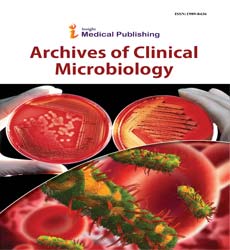Abstract
A Rationale for Maintaining Current Tigecycline Breakpoints as Established by the USA Food and Drug Administration
Background: Tigecycline has demonstrated good rates of microbiological eradication and clinical cure among indicated infections [Complicated intra- Abdominal infections (cIAIs), complicated Skin and Skin Structure Infections (cSSSI), Community-Acquired Bacterial Pneumonia (CAP), in the USA]. This investigation evaluates the FDA approved breakpoints for tigecycline using microbiological and clinical data derived from cSSSI, cIAI and CAP clinical trials.
Methods and findings: Clinical and microbiological success rates from phase III and phase IIIb/IV clinical trials were analyzed by MIC. Additionally, a surveillance program was utilized to assess changes in the antimicrobial potency of tigecycline between 2004 and 2012. Microbiological eradiation and clinical cure rates for patients with infections caused by Enterobacteriaceae at a tigecycline MIC of ≤2 mg/L or S. aureus with a tigecycline MIC of ≤0.5 mg/L were ≥81%. Against tigecycline non-susceptible pathogens microbiological and clinical successes were reported for 13/22 (59.1%) and 12/22 (54.5%), respectively. Using the Fisher’s exact test a comparison of microbiological success rates for patients (ME population) with Enterobacteriaceae with tigecycline MICs of ≤2 mg/L (n=922) and ≥4 mg/L (n=16) yielded a statistically significant two-tailed P value of 0.046. In the case of S. aureus, a comparison of MICs of ≤0.5 mg/L (n=287) and ≥1 mg/L (n=1) gave no statistically significant difference (P=1.000). Using the Cochran Armitage trend test statistically significant increases in tigecycline in vitro susceptibility were observed for Enterobacter spp. (p<0.01) and Enterobacteriaceae (p<0.01) and a statistically significant decrease in susceptibility among Enterococcus faecium (p<0.0001).
Conclusions: The current clinical FDA breakpoints for tigecycline are appropriate. Only E. faecium has shown a statistically significant decrease in susceptibility to tigecycline since tigecycline was first introduced into clinical practice in the USA in 2005.
Author(s):
David P. Nicolau, Alvaro Quintana, Joan M. Korth- Bradley, Michele Wible, Michael J Dowzicky
Abstract | Full-Text | PDF
Share this

Abstracted/Indexed in
- Google Scholar
- Open J Gate
- Genamics JournalSeek
- The Global Impact Factor (GIF)
- Open Archive Initiative
- China National Knowledge Infrastructure (CNKI)
- Scimago
- Directory of Research Journal Indexing (DRJI)
- WorldCat
- Proquest Summons
- Publons
- MIAR
- ResearchGate
- University Grants Commission
- Geneva Foundation for Medical Education and Research
- Secret Search Engine Labs
Open Access Journals
- Aquaculture & Veterinary Science
- Chemistry & Chemical Sciences
- Clinical Sciences
- Engineering
- General Science
- Genetics & Molecular Biology
- Health Care & Nursing
- Immunology & Microbiology
- Materials Science
- Mathematics & Physics
- Medical Sciences
- Neurology & Psychiatry
- Oncology & Cancer Science
- Pharmaceutical Sciences

